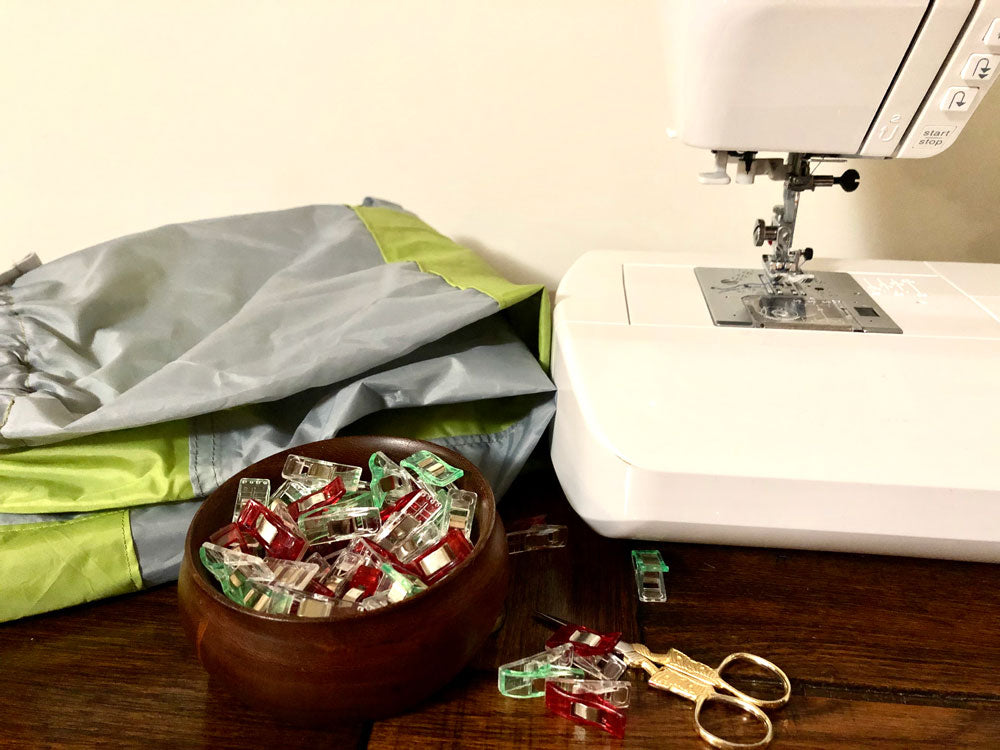Today we are getting ready to sew our Rainhaven Overalls! We will start by preparing our sewing machine, cutting out our pieces and then sew. Sewing a waterproof garment isn’t hard, but there are some things that we do a little differently.
Preparing your machine for sewing waterproof fabric
You will sew your waterproof garments on a regular sewing machine. In fact, you can sew these garments with the most basic of machines as you will only need a straight stitch (you may choose to use a zig zag stitch for finishing the edges of fabrics that fray or for joining your elastic). But there are a few things you can do to prepare your machine for sewing your waterproof fabric.
Using a fresh sewing machine needle is always a good idea. We have a blog post on choosing the right needle for your sewing projects.
For your waterproof fabric, we recommend an 80/12 universal needle for light-weight fabric or a 90/14 for medium-weight fabrics. If you are sewing with a heavier fabric, you may need a microtex or denim needle, and if your fabric is PUL or softshell, you might find that a ballpoint needle works better (as these are sometimes laminated knit fabrics).
Test out your needle on a scrap of your fabric to ensure that you have no skipped stitches and that it is sewing well.
If your fabric is ‘sticky’(eg. PUL or latex), you might want to try using a non-stick or TEFLON foot on your machine. If you don’t have one, you can apply some invisible tape to the bottom of your regular machine foot and the plate of your sewing machine to help the fabric slide through (do not cover the feed dogs).

Thread your machine with your 100% polyester thread and you are ready to sew!
Cutting out waterproof fabrics
The type of fabric you choose to use will influence the ease of cutting your waterproof fabric. Medium-weight fabrics will be easier to cut than light-weight fabrics, which have a tendency to be slippery and move around.
It is important when using waterproof fabrics to minimise the number of ‘holes’ you put in the fabric with pins and needles. So we recommend that you do not pin your pattern to the fabric. Instead, weigh it down with some sort of pattern weight. You may like to make a dedicated set of pattern weights using our tutorial.
If your fabric is slippery, it may be easiest to trace around the pattern onto the fabric and then cut out, rather than trying to cut around your pattern pieces. And it might be easiest to cut the large pieces (legs) one at a time, rather than with fabric folded in half – just make sure you cut mirror images!

Check that you have cut all of the required pieces for your garment on the cutting list in your pattern and also mark all the notches on your pieces with a small snip in the seam allowance or with a washable marker.
Important reminders
While sewing, continue to avoid using pins. You can use sewing clips, pegs or similar to hold your pieces together instead.
Do NOT use an iron. Waterproof fabrics are usually synthetic, or coated with a wax/oil substance. Ironing your fabric will result in destroyed fabric, iron and ironing board. Instead, firmly press your seams with your fingers.
Attaching Patches
If you are adding the optional patches to your garment, you will need to add them before you sew up the legs.
On each of your patches, you will need to fold over the top and bottom to the wrong side of the fabric. Use a few clips to hold the hand pressed edges under all the way across. Line up the notches on your patches with the corresponding notches on your leg pieces (front for knee patches, back for seat patches), and use more clips to clip the sides of the patches to the right side of the leg pieces. I like to sew within the seam allowance down one side first to secure, and then continue around the outside of the patch.

The Basic Seams
The seams on each side of the legs and the crotch are sewn with two rows of stitching. This gives the garment a neat finish and makes the seams much more waterproof than if sewn just once.
To sew the seams, you will place your pieces right sides together (matching any notches) and sew the seam.
Trim the seam allowance and then use your fingers (DO NOT iron!) to press both seam allowances to one side and then sew the seam allowances down with a second line of stitching.
Your seam will look like this from the outside.

Attaching the Bib Pocket
Prepare your pocket pieces as per the pattern. If you want to add grommets to the bottom of your pocket (to help drain out any water), do that before you sew the pocket to the bib.
Once you have sewn your overalls together, you can add the pocket to the bib. This can be a bit tricky to get straight if you are avoiding using pins, so take your time.
You can snip holes in your paper pattern along the pocket/flap placement lines and lay the pattern on top of your fabric to mark these with a washable marker. Place your pocket onto your overalls and check that you are happy with its placement. You want it to be right in the middle of the bib and level. Once I am happy with my pocket placement, I like to trace around the edge of the entire piece with a washable marker so that I can line it up as I sew. You can also use some masking tape to hold the pocket in place while you sew.

NB: You don’t have to put any pocket closures on, but if you choose to, you might want to consider adding the closures to the pocket and/or flap before you sew them to your overalls. For example, if you are using hook and loop tape, sew the piece of loop tape (the soft side) to your pocket before you sew the pocket onto the overalls. You can then line up the position for the hook piece to be added to the flap after it has been sewn onto your overalls.
Sewing with a cotton woven (or other non-waterproof fabric)…..
If you have chosen to make your Rainhaven garment from non-waterproof fabric such as cotton canvas, we recommend that you sew the garment first and then waterproof the finished garment (if you choose to). This will stop you from getting beeswax residue on your sewing machine.
If your fabric is prone to fraying, it is a good idea to finish the seam allowance before sewing it down. You can do this by trimming the seam allowance with pinking shears, overlocking/serging the seam allowance or using a zig zag stitch. Once you have done this, sew the seam allowance down the same as you would for other fabrics.
If you are sewing with a non-waterproof fabric, you may use pins and an iron to press the seams if you wish.

I hope these tips will be helpful for you in sewing your overalls together. Next time we will add the straps and finishing touches.
Measuring for a good fit
Preparing your pattern
Natural and eco friendly fabric and hardware options


